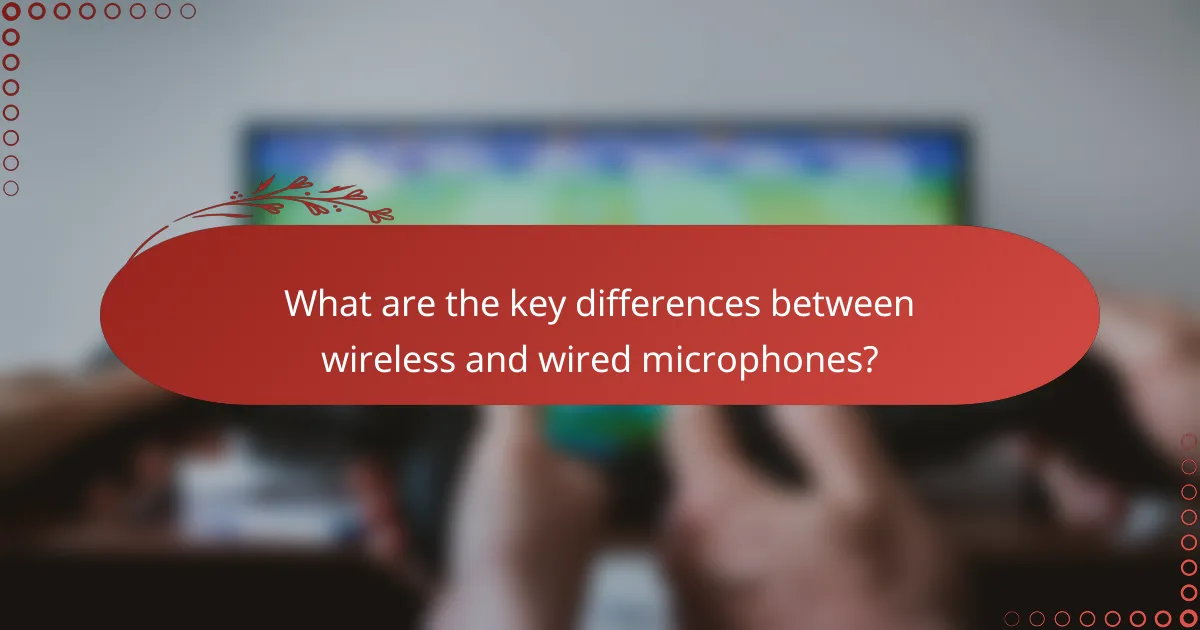Choosing between wireless and wired microphones depends on the specific requirements of your event. Wireless microphones offer the freedom of movement, making them perfect for dynamic performances, while wired microphones ensure consistent audio quality and reliability, ideal for settings where stability is crucial.

Which microphone type is best for live performances?
The best microphone type for live performances depends on the specific needs of the event. Wireless microphones are ideal for performers who require freedom of movement, while wired microphones are preferred for their consistent audio quality and reliability.
Wireless microphones offer mobility
Wireless microphones provide the advantage of mobility, allowing performers to move freely on stage without being tethered by cables. This is particularly beneficial in dynamic performances, such as dance or theater, where movement enhances the overall experience.
However, wireless systems can be affected by interference from other devices, so it’s essential to choose a quality system and conduct a frequency scan before the performance. Battery life is another consideration; always have spare batteries on hand to avoid interruptions.
Wired microphones provide reliability
Wired microphones are known for their reliability and consistent sound quality, making them a staple in many live performance settings. They are less susceptible to interference and do not require batteries, ensuring that they work whenever plugged in.
While they limit mobility, wired microphones are often preferred in environments where sound quality is paramount, such as in studio recordings or when using high-end audio equipment. It’s important to manage cables properly to avoid tripping hazards and ensure a tidy stage setup.
Popular choices include Shure SM58 and Sennheiser EW 100
Two popular choices for live performances are the Shure SM58 and the Sennheiser EW 100 series. The Shure SM58 is a legendary wired microphone known for its durability and excellent vocal reproduction, making it a favorite among singers and speakers alike.
On the other hand, the Sennheiser EW 100 series offers a reliable wireless solution with a range of features, including easy frequency management and robust transmission. Both options are widely used in the industry, catering to different performance styles and requirements.

When should I use a wireless microphone?
A wireless microphone is ideal when mobility and freedom of movement are essential. They are particularly useful in settings where the speaker needs to move around freely without being tethered to equipment.
Ideal for dynamic stage performances
Wireless microphones are perfect for dynamic stage performances, such as concerts and theater productions, where performers need to move around the stage. The absence of cables allows for greater creativity and interaction with the audience.
When choosing a wireless mic for stage use, consider factors like battery life, range, and frequency compatibility. Look for systems that offer low latency and robust signal strength to avoid dropouts during performances.
Useful for presentations and public speaking
In presentations and public speaking events, wireless microphones provide the speaker with the freedom to engage with their audience without being restricted by cords. This setup enhances the overall experience, allowing for better eye contact and interaction.
For effective use, ensure the microphone is properly paired with its receiver and test the audio levels beforehand. Opt for models with good noise cancellation features to minimize background noise, which can be crucial in large venues or crowded spaces.

When should I use a wired microphone?
A wired microphone is best used in situations where stability and sound quality are paramount. They provide a reliable connection and are less prone to interference, making them ideal for specific environments and applications.
Best for studio recordings
In studio settings, wired microphones are preferred due to their superior sound fidelity and consistency. They capture audio without the risk of dropouts or interference, which is crucial for professional recordings. Using high-quality XLR cables can further enhance audio clarity and reduce noise.
For studio recordings, consider using condenser microphones, which are sensitive and ideal for vocals and acoustic instruments. Dynamic microphones are also a good choice for louder sources, such as drums or guitar amplifiers, ensuring clear sound capture without distortion.
Recommended for high-noise environments
Wired microphones excel in high-noise environments, such as live events or crowded venues, where they can effectively minimize background noise. Their direct connection to the audio source helps maintain sound quality, even in challenging conditions.
When using wired microphones in noisy settings, opt for dynamic models with cardioid patterns, as they focus on sound from the front while rejecting noise from the sides and rear. This can significantly improve audio clarity in environments like concerts or public speaking events.

What are the key differences between wireless and wired microphones?
Wireless microphones transmit audio signals without physical cables, while wired microphones rely on cables for signal transmission. The choice between them depends on factors like mobility needs, sound quality requirements, and specific use cases.
Signal transmission methods
Wired microphones use cables to connect directly to audio equipment, ensuring a stable and reliable signal. Common cable types include XLR and TRS, which are standard in professional audio settings.
In contrast, wireless microphones transmit audio signals via radio frequencies or infrared signals. They consist of a transmitter, which captures the audio, and a receiver, which connects to the audio system. This setup allows for greater freedom of movement but can be susceptible to interference from other wireless devices.
Latency and sound quality considerations
Wired microphones typically offer lower latency and superior sound quality, making them ideal for professional environments where audio fidelity is crucial. They are less prone to signal degradation and do not require batteries.
Wireless microphones, while convenient, may introduce latency, which can affect live performances or recordings. Additionally, sound quality can vary based on the wireless technology used. High-quality wireless systems can minimize these issues, but they often come at a higher price point.

How do I choose the right microphone for my needs?
Choosing the right microphone depends on your specific requirements, including the environment, intended use, and budget. Assessing these factors will help you determine whether a wired or wireless microphone is more suitable for your situation.
Consider the environment and use case
The environment where you plan to use the microphone significantly influences your choice. For instance, in a controlled studio setting, wired microphones often provide superior sound quality and reliability. In contrast, for live performances or events where mobility is essential, wireless microphones offer freedom of movement.
Think about potential interference and range as well. Wireless microphones can be affected by obstacles and electronic devices, while wired options are less prone to these issues but limit your movement. Understanding the specific conditions of your use case will guide your decision.
Evaluate budget and brand reputation
Your budget will play a crucial role in selecting a microphone. Wired microphones generally cost less than their wireless counterparts, making them an attractive option for those with limited funds. However, investing in a reputable brand can ensure better sound quality and durability, which may save you money in the long run.
Research brands known for their reliability and customer support. Look for user reviews and expert recommendations to gauge the reputation of different models. Balancing cost with quality will help you make a more informed choice that meets your needs without overspending.

What are the compatibility options for microphones?
Microphone compatibility options depend on the devices and audio interfaces you plan to use. Understanding these options ensures optimal performance and connectivity, whether you choose wired or wireless microphones.
Check device compatibility with audio interfaces
Before purchasing a microphone, verify that it is compatible with your audio interface. Most interfaces support XLR connections for wired microphones, while wireless options may require specific receivers or transmitters. Check the specifications of both the microphone and the audio interface to ensure seamless integration.
For instance, if you are using a USB audio interface, ensure the microphone has a USB output or that you have the necessary adapters. Compatibility can significantly affect sound quality and latency, so it’s crucial to confirm these details beforehand.
Explore adapters for different setups
Adapters can bridge compatibility gaps between microphones and devices. For example, if you have a 3.5mm microphone but need to connect it to an XLR input, a 3.5mm to XLR adapter will be necessary. Similarly, if using a wireless system, ensure you have the right connectors for your setup.
When selecting adapters, consider the quality and potential signal loss. High-quality adapters can maintain audio integrity, while cheaper options might introduce noise or degrade sound quality. Always choose adapters that match your specific microphone and device requirements to avoid issues during use.

What are the shipping and return policies for microphones?
Shipping and return policies for microphones can vary significantly between retailers. It’s essential to understand these policies before making a purchase to avoid unexpected costs or complications.
Free shipping options available
Many retailers offer free shipping on microphones, especially for orders over a certain amount, typically ranging from $50 to $100. Some online stores may provide free shipping promotions during specific sales events or for members of loyalty programs.
When shopping, look for retailers that clearly state their free shipping options at checkout. This can help you save on costs, particularly if you are purchasing multiple items.
Return policies vary by retailer
Return policies for microphones differ widely among retailers, with some offering a 30-day return window while others may extend it to 90 days or more. It’s crucial to check if the retailer allows returns on opened items, as some may only accept returns for unopened products.
Before purchasing, review the return policy details on the retailer’s website. This will help you understand any restocking fees or conditions that may apply, ensuring a smoother return process if needed.

What are the emerging trends in microphone technology?
Emerging trends in microphone technology focus on advancements in wireless capabilities, improved sound quality, and enhanced user convenience. Innovations such as digital signal processing and miniaturization are making microphones more versatile and accessible for various applications.
Advancements in wireless technology
Wireless microphones are becoming increasingly sophisticated, with improvements in battery life, signal range, and audio fidelity. New protocols, such as Bluetooth 5.0 and advanced RF technologies, allow for clearer sound transmission and reduced interference, making them suitable for live performances and broadcasting.
When choosing a wireless microphone, consider the environment where it will be used. For instance, venues with many electronic devices may require models with frequency-hopping capabilities to avoid signal loss.
Improved sound quality
Recent developments in microphone design, including better diaphragm materials and advanced circuitry, have significantly enhanced sound quality. Many modern microphones now offer flatter frequency responses and lower self-noise levels, making them ideal for professional recording and live sound applications.
For example, condenser microphones are favored for studio recordings due to their sensitivity and clarity, while dynamic microphones are often preferred for live settings due to their durability and ability to handle high sound pressure levels.
Integration with smart technology
Microphones are increasingly being integrated with smart technology, allowing for features like voice activation and remote control. This trend is evident in consumer electronics, where smart home devices utilize built-in microphones for voice commands and communication.
When selecting a microphone for smart applications, ensure compatibility with existing systems, such as smart speakers or home automation setups, to maximize functionality and ease of use.










